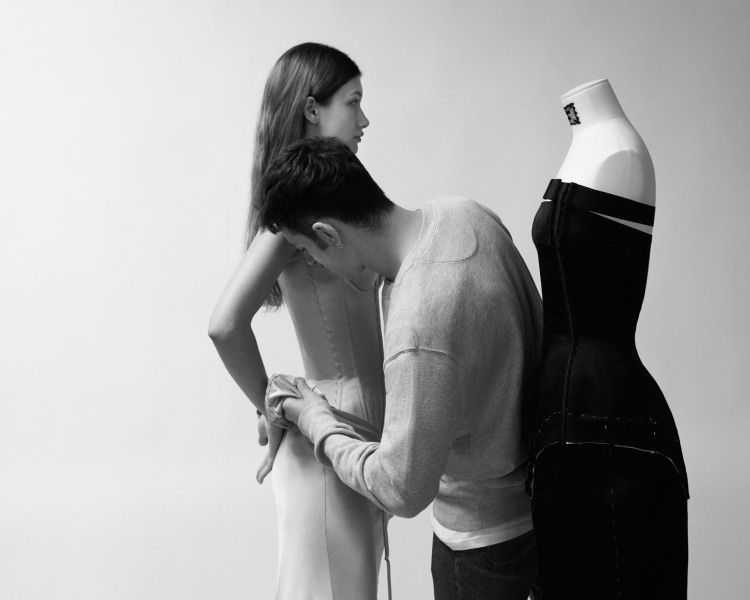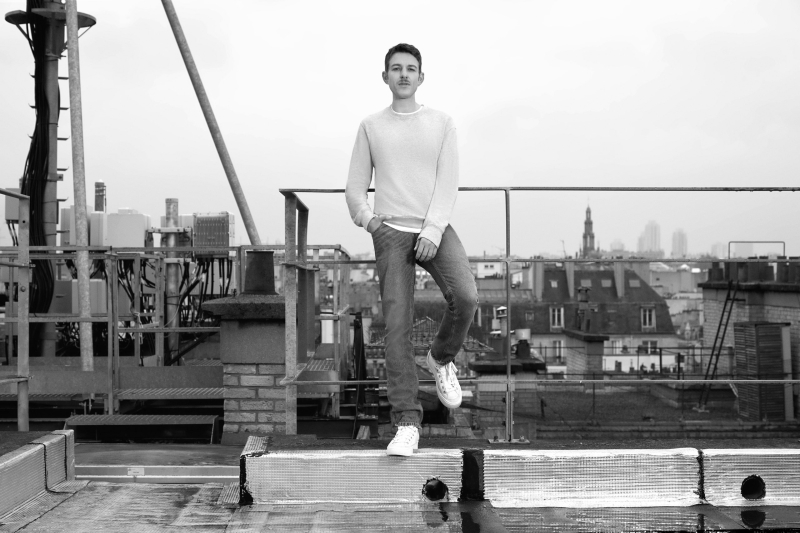Last week, Nicolas Di Felice, the artistic director of Courrèges, posted to Instagram Stories a video he had taken of the Paris skyline at night, his camera slowly panning across the city. Di Felice had taken the video from a vantage point relatively new to him: the roof of the Jean Paul Gaultier atelier on Rue Saint Martin in the city’s Marais neighborhood, where he has been working since late last year on his vision of haute couture for the house. It will be shown tomorrow amidst the other fall 2024 couture shows, with Di Felice joining the ever-growing roll call of designers who have guested at Gaultier for one season, including Haider Ackermann, Simone Rocha, Glenn Martens, and Olivier Rousteing.
Di Felice’s video couldn’t have been a more cinematic — or evocative—curtain-raiser on what it means to design the couture for one of the most iconic designers ever. Put simply: It means that you’re at the very pinnacle of Paris fashion. Gaultier, after all, is the designer who made Paris cool in the 1980s (snatching the crown from London) with his insanely influential collections which, over the years and decades, riffed on everything from underwear-as-outerwear, with all its corsetry lacing and pointy bras, to pinstripe tailoring, tattoos, traditional Hasidic dress, Breton stripes, punk, piercings, Mongolia, and Folies Bergère feathers—all of it worn by everyone from Madonna to Neneh Cherry, and all the while becoming a pop cultural icon in his own right. The designer worked with director Pedro Almodovar, co-hosted the cultish British TV show Eurotrash (divinely hilarious; go YouTube it) and, in 1989, recorded his very own pop song, “How To Do That,” more of which later.
Gaultier is, says Di Felice, someone whose power to inspire is undiminished. “Jean Paul has always expressed a lot to people,” he told me. “He passed by the opening of the new Courrèges store last night, and everyone was like ‘Ahhh!’ You talk to designers of my generation, to the young generation, everyone, he’s a star. When I was a kid, he was the only famous designer in the countryside, because everyone would wear his perfume—men and women—and he was on television because he was dressing Madonna. And honestly,” Di Felice went on to say, “Jean Paul really showed for the first time queer communities, different ethnicities, different bodies—he was the precursor of everything we see now. And it’s really Paris as well, you know? For me, if I have one image [of what Gaultier has done], it’s like I’m coming to Paris to be myself.”
Di Felice is telling me this via Zoom. We’re chatting because we’re previewing his couture for the label, an exercise which requires him to find a connection strong enough and powerful enough to tell the story of his vision of Gaultier—the man, the designer, and the house—and do it all at once, for one time only. (“I always say, One season at a time—I can always keep something for the following season,” said Di Felice, “but not this time.”) Clearly he feels no lack of personal connection. And also, as the preview went on, it’s clear he felt no lack of aesthetic connection—or inspiration—either. Of course, given this story you’re reading is a preview, it can only say so much, because… you know, umm, spoilers. If you want to get the fullest look at Di Felice's exceptional Gaultier couture, you will have to go read Nicole Phelps’s review and then study each of the 32 (at the time of writing) looks he’s going to show. But because I hate to be too much of a tease, here are some words to mull over until then: undress, gazar, slash, sleeves, leather, and hook and eye. That’s it—and even now I have probably said too much. (You also get a little sneak peak below!)

What we can talk about is the route Di Felice took to arrive at his Gaultier couture. From the minute he started work, it quickly became apparent to him, he says, that what would be challenging was, “deciding where I wanted to go—because obviously I really dug into the archives big, big time. I mean, I have loved his work for a long time, so I knew lots of pieces. I even found images of Jean Paul’s first, first collection—he doesn’t even have that many pictures of it himself. All of a sudden, I was seeing a show from the ’70s which was really amazing. And he did so much that was interesting. Not just the couture, but Junior Gaultier, Soleil, the jeans…. He was so prolific that I didn’t want to be inspired by only one collection, or a certain iconic look. I thought about what really touched me, and what made sense to the way I work. As I did this collection, I learned about that every day.”
What Di Felice knew from the outset was that he himself was not, he said, “a fan of decoration.” Which meant that what so many of us think of as haute couture—insane levels of beading and feathering and embroidering and all that jazz—are really not part of Di Felice’s vision. Again, without giving a whole lot away, there will be some embellishment going on, with the aforementioned hook and eye to the fore—he laughed that the Gaultier studios were buying all that they could lay their hands on. But really what his couture—along with his work at Courrèges—is about is the elemental power of fabric draped onto the body: the alchemical reaction that happens when the two-dimensional meets the three-dimensional. Some of what Di Felice has done might at first glance seem almost like nothing—I’m thinking of one dress (at the time of writing, look 11)—but of course it’s not; it’s quite, quite something, by virtue of all the work to make the outward (the gazar) and the inward (the boning construction) look absolutely effortless. Over the Zoom, Di Felice undid the dress, and it opened like an exhale—as natural and as effortless as breathing: a beautiful piece of workmanship.
“Most of the patterns are really geometric shapes,” Di Felice said. “I am going to show you look 1”—he ran across the studio and pointed the phone to the floor, where it was laid out, utterly flat on the ground—“that’s the feeling I am going for. You can do nice drawings—you can draw, and draw, and draw —but you want to do something outstanding [for couture], and the magic can come from just a simple square of fabric. It’s going back to geometry; it’s a never-ending principle, because it gives you a lot to play with.” One collection he did look at was “Les Touristes Japonaises au Louvre” of Spring 1999 . “The set was a huge red circle, super radical,” said Di Felice. “It’s simple, which I like, but most of all, it’s the amazing way he cut that collection that I like; even if some were really simple gestures, they really touched me.” (Another collection he was looking at, for reasons that will become evident, was Gaultier’s fall of 1986/87, dubbed “Constructivism.” Ditto the “Women Among Women” collection of Fall 1989.)
Of course, when one guests as the designer responsible for the couture of Gaultier, you’re following not only in the footsteps of the man himself, but all those who have sat in the couturier seat for one season. “I’m not the first person to do this collaboration, and it was important for me to work around things that are perhaps less-known,” Di Felice said. “Jean Paul never stopped searching and expressing, and it would be a bit predictable to always go back to the same things. The designers who went before me are really talented and have amazing taste, and because we are the same age, [I thought] maybe we’d be drawn to the same things, but that thought didn’t last long.” Di Felice, an inveterate team player, also praised the Gaultier atelier teams for being so brilliant to work with. “They’re passionate and nice people,” he said. “[Always working with new designers] demands a lot of flexibility and intelligence and patience. It’s [a lot] to change artistic direction every six months. I was really curious about so many of the techniques. I learned a lot about myself, and my tastes. And thank God what I wanted to work on [of Gaultier’s past] hadn’t been that touched.”
One less-expected thing that guided him was that Gaultier song, “How To Do That.” “I became obsessed with this one line in the song—‘There is a new way, a new way, a new way’,” Di Felice said. “I don’t want people to think I am saying that I am going to do [my Gaultier couture] in a new way—not at all! It’s something that has just run in my mind since the first day I started because I don’t want to disappoint him. Or disappoint myself.”

